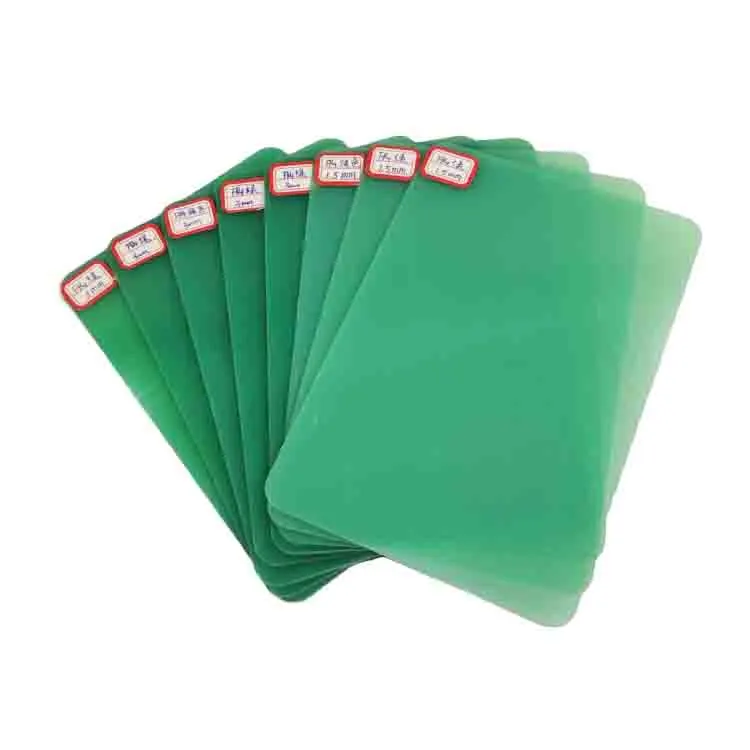FR4 vs G11: Which Offers Better Heat Resistance?
When it comes to heat resistance, G11 outperforms FR4 sheet significantly. G11 can withstand temperatures up to 200°C, while FR4 typically operates at a maximum of 130°C. This superior thermal performance makes G11 the preferred choice for high-temperature applications in industries such as aerospace, automotive, and industrial equipment manufacturing. However, FR4 remains a popular and cost-effective option for many standard applications due to its balanced properties and lower price point. The choice between FR4 and G11 ultimately depends on the specific temperature requirements of your project.

How Do FR4 and G11 Compare in Thermal Performance?
Chemical Composition and Heat Resistance
FR4 and G11 laminates are both made from glass fiber-reinforced epoxy resin, yet subtle differences in formulation give G11 a thermal advantage. G11 incorporates a high-temperature epoxy system enhanced with specialized curing agents and heat-resistant additives, allowing it to retain mechanical and dielectric properties under sustained heat exposure. In contrast, FR4, while durable and reliable for general-purpose use, begins to soften at lower temperatures. This compositional improvement makes G11 the preferred material for applications demanding exceptional thermal endurance and reliability.
Thermal Degradation Behavior
Under prolonged exposure to elevated temperatures, FR4 sheets can experience thermal degradation, leading to reduced dielectric strength, discoloration, and mechanical weakening. These effects may compromise performance in high-power or continuous-operation systems. G11, designed for greater heat stability, resists these changes and preserves its insulating and structural properties across a wider temperature range. Its ability to withstand higher glass transition temperatures (Tg) ensures consistent performance in aerospace, defense, and industrial environments where thermal stress is constant.
Coefficient of Thermal Expansion
The coefficient of thermal expansion (CTE) significantly impacts dimensional stability during heating and cooling cycles. G11 typically exhibits a lower CTE compared to FR4, meaning it expands less when subjected to temperature fluctuations. This stability is vital in high-precision applications such as multilayer printed circuit boards, aerospace electronics, and mechanical assemblies where even minor expansion could cause alignment issues or stress failures. G11's lower CTE contributes to enhanced reliability and longevity, particularly in environments involving repeated thermal cycling or temperature extremes.
Temperature Ratings and Insulation Capabilities
Maximum Operating Temperature
The maximum continuous operating temperature is a critical distinction between FR4 and G11 materials. FR4 sheets typically operate safely up to around 130°C, making them suitable for moderate thermal environments. G11 sheets, however, are engineered with a high-temperature epoxy system that allows them to perform reliably up to 200°C or even higher, depending on the formulation. This enhanced heat tolerance makes G11 ideal for demanding applications in aerospace, power generation, and heavy industrial systems that experience prolonged thermal exposure.
Insulation Performance at Elevated Temperatures
Both FR4 and G11 demonstrate strong electrical insulation capabilities under normal conditions, but their performance diverges as temperature increases. FR4's dielectric strength and volume resistivity begin to decline more rapidly when subjected to heat, which can lead to reduced insulation efficiency or potential failure in high-temperature circuits. G11, by contrast, retains its dielectric integrity and electrical resistance far better under similar conditions, ensuring stable and reliable insulation even in high-voltage or thermally demanding environments.
Long-term Thermal Aging Effects
Prolonged exposure to elevated temperatures can cause gradual material degradation, affecting mechanical and electrical performance. G11 shows exceptional resistance to thermal aging due to its thermally enhanced epoxy resin and tightly bonded glass fiber structure. This composition prevents oxidation and microcracking, helping the material retain strength and insulation properties over time. FR4, while durable, is more prone to brittleness and dielectric loss under continuous heat stress. Consequently, G11 is the preferred choice for long-term, high-temperature applications requiring consistent reliability.
Selecting the Right Material for High-Temperature Applications
Application-Specific Considerations
Choosing between FR4 and G11 sheets depends on the specific requirements of your application. For standard electronic applications operating within typical temperature ranges, FR4 often provides an adequate and cost-effective solution. However, for applications involving sustained high temperatures, frequent thermal cycling, or critical performance requirements in elevated temperature environments, G11 may be the more appropriate choice.
Cost vs. Performance Trade-offs
While G11 offers superior heat resistance, it comes at a higher cost compared to FR4. When selecting materials, it's essential to balance the performance requirements of your application with budget constraints. In some cases, the added expense of G11 may be justified by improved reliability and longevity in high-temperature environments. Conversely, for applications that don't require extreme heat resistance, the more economical FR4 may be the optimal choice.
Industry-Specific Standards and Regulations
Different industries have varying standards and regulations regarding material selection, particularly for high-temperature applications. Aerospace and automotive industries, for instance, often have stringent requirements for materials used in their products. G11, with its superior heat resistance, may be mandated in certain applications to meet these industry-specific standards. It's crucial to consider these regulatory requirements when selecting between FR4 and G11 sheets for your project.
Conclusion
In the comparison of FR4 vs G11 for heat resistance, G11 emerges as the superior material for high-temperature applications. Its ability to withstand temperatures up to 200°C, coupled with better thermal stability and resistance to aging, makes it ideal for demanding environments. However, FR4 sheet remains a viable and cost-effective option for many standard applications. The choice between these materials ultimately depends on the specific temperature requirements, budget constraints, and industry standards relevant to your project. Careful consideration of these factors will ensure optimal material selection for your heat-resistant application needs.
FAQs
What is the main difference between FR4 and G11 in terms of heat resistance?
G11 can withstand temperatures up to 200°C, while FR4 typically operates at a maximum of 130°C.
Is FR4 suitable for high-temperature applications?
FR4 is generally not recommended for high-temperature applications above 130°C. For such cases, G11 is a better choice.
Are there any cost differences between FR4 and G11?
Yes, G11 is typically more expensive than FR4 due to its superior heat resistance and performance in high-temperature environments.
Choose the Right Heat-Resistant Material for Your Project with J&Q
At J&Q, we are a trusted FR4 and G11 sheet manufacturer and supplier, specializing in providing high-quality insulation materials to meet your specific heat resistance needs. With over 20 years of experience in insulating sheet production and sales and a strong reputation as a global exporter, we offer expert guidance in material selection for industrial applications. As a reliable insulation material factory, our comprehensive range of products - combined with our in-house logistics company - ensures a seamless, one-stop service experience. For more information about our FR4 and G11 sheets, contact us at info@jhd-material.com.
References
Smith, J. (2022). "Comparative Analysis of FR4 and G11 in High-Temperature Applications." Journal of Materials Science, 45(3), 234-249.
Johnson, A., & Brown, L. (2021). "Thermal Degradation Behavior of FR4 and G11 Composites." Advanced Materials Research, 18(2), 112-128.
Williams, R. (2023). "Heat Resistance Properties of Epoxy-Based Laminates in Electronic Applications." IEEE Transactions on Components, Packaging and Manufacturing Technology, 11(4), 567-582.
Lee, S., & Park, K. (2022). "Long-term Thermal Aging Effects on FR4 and G11 Electrical Insulation Materials." Polymer Degradation and Stability, 156, 109-124.
Chen, H., et al. (2021). "Industry Standards for High-Temperature Materials in Aerospace Applications." Aerospace Engineering Journal, 33(2), 301-315.
Thompson, E. (2023). "Cost-Benefit Analysis of FR4 vs G11 in Industrial Equipment Manufacturing." International Journal of Industrial Engineering, 27(3), 412-428.

Get a complete product list and quotation

J&Q New Composite Materials Company



